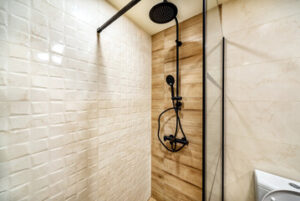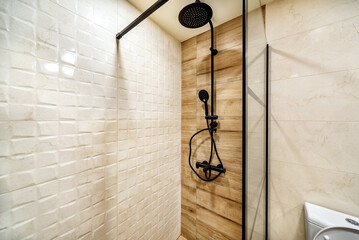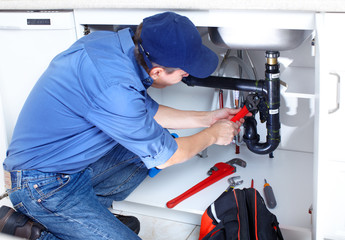Bathroom improvements offer a good return on investment and can make a home more appealing to buyers. Frameless glass shower doors add an upscale flair to the space and open up the room.
They’re also easy to clean since frames create nooks where soap scum collects. However, these doors require clips and hinges to attach them to the wall, which can be more labor-intensive to install than framed doors. Visit https://glassgovernor.com/ to learn more.
Shower doors are an important investment for homeowners, as they provide an elegant aesthetic to one of the most used spaces in the home. They also add value to the property, as potential buyers are drawn to bathroom features that are modern and sophisticated.
Frameless glass shower doors offer an understated elegance to any bathroom. These doors eliminate the appearance of bulky metal framing, and they allow light to flow freely through the space, making it appear larger and more spacious. Additionally, the frameless design of these shower doors allows homeowners to show off their beautiful stone tiles and other bathroom features without the distraction of a frame.
Additionally, because these doors are a less-invasive option than framed doors, they require far fewer maintenance elements. The absence of a frame creates no crevices for mold or mildew to grow, and it is much easier to maintain a clean and polished look for these doors with regular cleaning.
Lastly, these shower doors are very versatile and can be matched with any bathroom style. For example, our Metropolis Series would fit well in an Art Deco-inspired bathroom due to its influenced Tudor window architecture. In contrast, our Equalis Series is perfect for a contemporary bathroom due to its geometric and consistent design features.
In addition, these doors can be customized for any size shower to ensure the perfect fit. This versatility is key in ensuring that the bathroom meets the needs and aesthetics of the homeowner.
If you’re looking for a sleek and timeless upgrade to your bathroom, frameless glass shower doors are the perfect choice. With a minimalist design, they add an element of sophistication to any space and can be easily customized to match your unique aesthetics. Additionally, they are an affordable option that can significantly increase the resale value of your home.
Durability
Frameless glass shower doors allow natural and artificial light to shine throughout the bathroom, making it feel bigger. They also offer unobstructed views of decorative shower fixtures and intricate tiling, helping them to take center stage in the room. This upscale design helps to elevate the overall look and feel of the space, making it more appealing to potential homebuyers.
While it is true that frameless shower doors have a higher cost than framed ones, they are worth the investment. They are also very durable and long-lasting, requiring minimal maintenance. They are made of tempered glass, which is more resistant to breaking than traditional laminated or annealed glass. The lack of metal framing also makes them less susceptible to rust and corrosion.
Additionally, they are more hygienic than framed doors. Without a frame, there are fewer areas for soap scum and dirt to accumulate. This can make cleaning your frameless shower door a quicker and easier process.
Another advantage of frameless glass shower doors is their safety. Tempered glass is designed to minimize injury in the event of a break. The glass is reinforced with a tough polymer resin that increases its strength and durability. This reduces the risk of glass shards flying around in your bathroom, which can cause serious harm to your family members and pets.
Many homeowners are hesitant to choose frameless shower doors because they fear that the glass will shatter. However, this is a false assumption that is not based in fact. While it is true that framed doors are more likely to break than their frameless counterparts, the vast majority of breaks that occur in home showers are due to physical trauma or negligence.
While the durability of frameless glass shower doors is a huge selling point, it’s also important to consider the installation process. It can be much more difficult to install frameless glass shower doors than framed ones, especially if your shower is not square or level. It can also be more costly because a professional will need to template the shower and cut the glass to size, which takes a little longer than a framed shower.
Security
Showers are one of the most common places for home improvement upgrades. As HGTV host Scott McGillivray points out, bathrooms are also one of the most popular rooms to improve in homes on the market because they can increase resale value significantly. Frameless glass shower doors are an especially attractive option because they can add a luxurious feel and make bathrooms appear larger.
While it’s true that frameless doors can cost more than framed shower doors, they’re still an affordable upgrade that’s sure to impress potential buyers. In addition, they’re available in a variety of different styles to suit any design.
If you choose to go with a frameless shower, make sure it’s made of tempered glass. Tempered glass is specially treated to increase strength and safety. If it does break, it shatters into small blunt pieces rather than sharp, dangerous shards. Look for certification labels that indicate that your frameless shower door is tempered.
Another consideration with frameless shower doors is that they’re heavier than their framed counterparts. This is due to the fact that they don’t have a solid frame to help support them. As a result, it’s important to hire a professional for installation. They’ll know how to perfectly level the clips that hold the doors to prevent them from sagging over time. They’ll also use thick silicone caulk to create a watertight seal around stationary panels to prevent leaks.
Although rare, frameless doors have been known to shatter when they’re slammed or otherwise mistreated. These incidents are usually the result of poor installation, damage to the glass itself, or severe or sudden changes in temperature or humidity. To avoid these problems, be sure to inspect your shower doors regularly and never slam them. Also, if you have kids, it’s a good idea to discourage them from running into the doors or banging on them. With proper care, your frameless shower will be a beautiful and functional part of your bathroom for years to come. Schedule a consultation with a glass solution company today to learn more about your options for frameless shower doors.
Easy Cleaning
Frameless glass shower doors are a sleek addition to any bathroom, and their minimal design means they’re much easier to clean than traditional shower enclosures. In fact, you can wipe down your frameless shower doors after every shower to prevent soap scum and water droplet buildup. This easy maintenance routine will keep your frameless glass shower doors looking shiny and new for years to come.
For stubborn stains, you can use a mixture of white vinegar and water or baking soda to safely remove them from your glass. Applying the solution with a non-abrasive sponge or microfiber cloth and gently scrubbing can yield impressive results. In addition, you can use a household product like Windex to remove stubborn mineral deposits from your glass surfaces.
Some glass shower doors are treated with a protective coating to help them resist staining and water spots. These products are available at many hardware stores, and they’re designed to help maintain the clarity of your glass shower doors for years to come. One product in particular, called Diamon-Fusion, uses nanotechnology to fill the natural pores of your glass, making it more resistant to stains and water marks.
If you have frameless glass shower doors with metal trim and hinges, you can polish them periodically to restore their shine. This will also help prevent rust and corrosion. In addition, you should regularly clean and inspect the shower door tracks and hinges to ensure they are free from dirt or debris that may interfere with their operation.
While frameless glass is more durable than a typical shower enclosure, it’s still important to exercise caution when cleaning your frameless doors. Avoid using abrasive scrub brushes or chemical cleaners, as these can scratch the glass and cause damage. Regularly wipe down your shower doors and the surrounding areas with a mild, non-abrasive cleanser to keep them looking their best.
For added convenience, you can invest in a shower squeegee to make cleaning your shower much faster and easier. These handy tools, which resemble windshield wipers and are usually mounted on the wall with suction cups, will remove soap scum, water droplets, and residue from your glass surfaces in just minutes. In addition, you can regularly use a silicone-based lubricant on the shower door tracks and hinges to keep them squeak-free and functioning properly.






